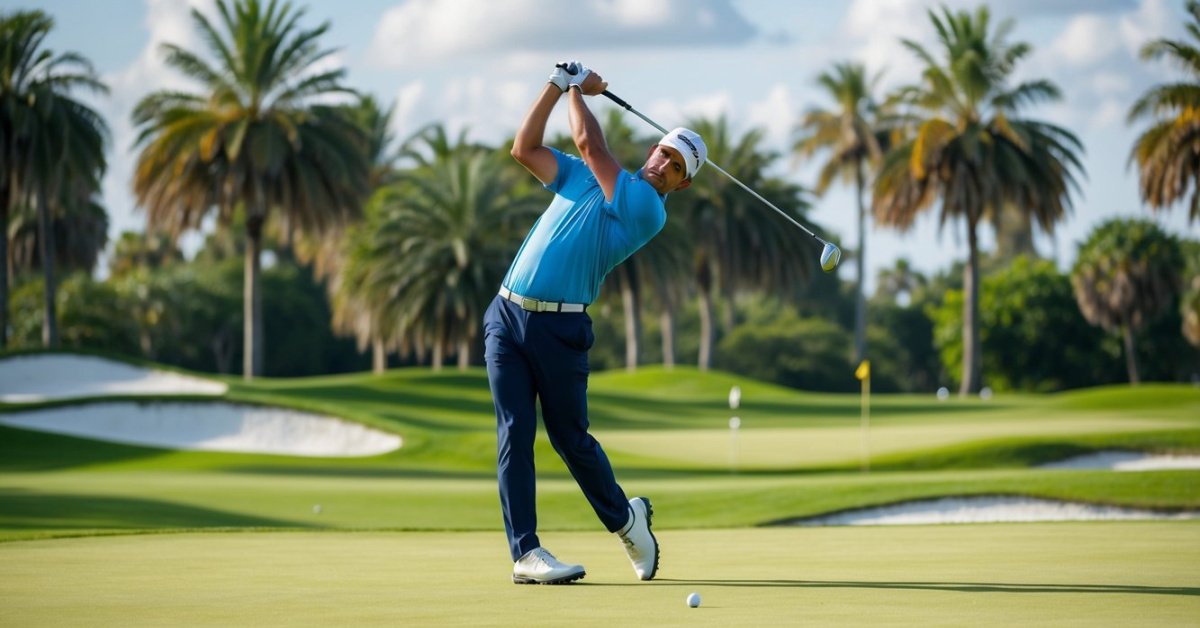Ever wonder why your golf ball seems to have a mind of its own, stubbornly refusing to soar down the fairway like you’ve envisioned? You’re not alone. It’s a common frustration, but the answer often lies in the subtleties of your swing.
The Importance of Technique
When you’re aiming to add distance to your drives, understanding the technical aspects of your swing is pivotal. It’s not simply about swinging faster or harder; it’s about optimal swing mechanics. As a low handicapper, you know that the devil is in the details – small adjustments can lead to significant improvements on the course.
Timing and Rhythm are everything in golf. Your body needs to work in a harmonious sequence, from the takeaway to the follow-through. Getting this right ensures the clubhead reaches its maximum velocity at the point of impact.
Consider these critical elements of technique:
- Grip: A proper grip allows for a fluid motion and affects the clubface alignment.
- Stance and posture: These are the foundations of a good swing. Ensure you’re balanced and ready to move with power.
- Backswing: A full backswing with the correct rotation sets you up for a powerful downswing.
- Downswing: This is where the magic happens. The sequence in which you uncoil your body is key to transferring energy efficiently.
- Impact: The clubface must strike the ball squarely for maximum compression.
Without delving into complex physics, every swing has an optimal angle of attack and swing plane. Straying from these can cause mishits and loss of power. Track down a certified PGA professional who can perform a swing analysis. With today’s technology, it’s easier than ever to get precise feedback on your swing.
Remember, technique refinement takes time. Patience and dedication to practice will pay off. Incorporate drills into your regimen that target each aspect of the swing. Range sessions become more than just hitting balls; they’re about intention and purpose.
Your goal is to make these technicalities second nature, allowing your body to execute them subconsciously during the game. This level of proficiency doesn’t just add yards to your drive; it infuses consistency and confidence into every shot you make. Keep pushing the limits and fine-tuning your technique, and you’ll undoubtedly start seeing your drives soar further down the fairway.
Understanding Clubhead Speed
When you’re on the course, watching your buddies smash the ball off the tee, you might wonder what their secret is. Well, it’s no secret that clubhead speed is a crucial factor. You’ve nailed down the essentials of your swing, but to add that extra zip, you need to elevate your clubhead speed.
Think of clubhead speed as the force that propels your golf ball to soar over the fairway. It’s the end product of all the energy transfer from your body through the club and into the ball. To enhance this speed, focus on building a more powerful swing motion rather than just muscling the ball.
« How Does a Golf Ball Drop Work? Unlock the Secrets to Perfect Trajectory
What Is a Soft Golf Ball Good For? Unlock Distance & Control Secrets »
Here’s where things get technical: your body acts like a whip, starting from your feet and moving up through your legs, hips, torso, shoulders, arms, and finally your wrists, which all contribute to speed. The sequence of these movements is critical. An efficient kinetic chain maximizes your output, ensuring that each segment of your body accelerates and then decelerates smoothly, transferring energy to the next part of the chain.
- Flexibility and Strength: Regular exercises that improve your flexibility and strength can have a direct impact on your swing speed. You’re looking for explosive power, which comes from strong and flexible muscles.
- Swing Mechanics: Pay attention to the width of your swing arc. A wider swing arc typically generates more speed, but only if it’s under control.
- Tempo: A smooth, rhythmic swing is often faster and definitely more consistent than one that’s hurried and erratic. Work on your timing and balance to maintain a good tempo.
- Equipment: Sometimes, even with the perfect swing, your gear might be holding you back. Make sure your clubs are properly fitted to your swing. A club that’s too long, too heavy, or with a shaft that doesn’t match your swing speed can reduce your clubhead speed dramatically.
Finding the Right Equipment
Sometimes the problem isn’t with your swing—it’s with the clubs you’re using. Just as a musician tunes their instrument, you need to ensure your equipment is tailored to your game. Don’t overlook the importance of playing with the right clubs.
Club fitting is not just for pros; it’s for anyone who wants to improve their game. During a fitting session, aspects such as shaft flex, length, lie angle, and grip size are customized. Here’s why they matter:
- Shaft flex impacts the flight of your ball. A shaft that’s too stiff or too flexible for your swing speed can lead to less distance.
- Club length affects your swing mechanics. Clubs that are too long or too short can throw off your posture and balance.
- Lie angle determines the clubface position at impact. Incorrect lie angles can result in wayward shots, sabotaging distance.
- Grip size influences your hand action. Too thick or thin, and it can hinder your ability to release the club properly.
If you’re serious about optimizing your distance, consider an equipment check-up. Here’s what to look at:
- Golf Ball Type: The construction of a golf ball, from its core to its cover, can dramatically affect how far it’ll fly. Low-compression balls can be especially beneficial to those with slower swing speeds.
- Driver Options: Modern drivers come with adjustable features that allow you to fine-tune loft and ball spin. These adjustments can add precious yards to your drives.
Keep in mind that technology advances. What was cutting-edge five years ago might be holding you back now. Upgrades in equipment can be game-changers. Investing in the latest clubs doesn’t just get you the newest technology, it gets you a custom fit designed for today’s game. So if you’re puzzled about your lack of distance, it might be time to consult with a golf shop professional and explore the possibility that new clubs could spark improvement in your drives.
Building Strength and Flexibility
When addressing why you don’t hit the golf ball as far as you’d like, consider your physical conditioning. Strength and flexibility are crucial components that affect your ability to swing the club with power and precision.
First off, building strength, particularly in your core and lower body, can have a substantial impact on your swing speed. You may have seen professional golfers with lean physiques, and there’s a reason for that. Greater core strength allows you to coil and uncoil during the swing, creating the necessary torque for a powerful drive.
Here are a few exercises you might want to incorporate into your regimen:
- Squats and lunges: for lower body power
- Planks and Russian twists: to enhance core stability
- Deadlifts: for overall strength, targeting the back, glutes, and hamstrings
Remember, it’s not just about lifting heavy weights. It’s about targeted exercises that enhance your ability to perform a fluid and strong swing.
Couple strength with flexibility, and you’ll be optimizing your swing mechanics drastically. Improving your flexibility allows for a wider range of motion, which can increase your swing arc. A longer swing arc can translate to higher swing speeds and thus, longer drives.
Consider adding a regular yoga or stretching routine to your schedule. Focus particularly on the hips, shoulders, and back, which are all pivotal for a smooth, unrestricted swing. Dynamic stretching can be especially beneficial just before your round, getting the muscles warm and ready to perform.
By enhancing your strength and flexibility, your swing won’t just get more powerful; your body will also be less prone to injury. With consistent practice and patience, you’ll likely see improvements not only in the distance of your drives but in the quality of your overall game. You’ll thank yourself when you start outdriving your buddies on the fairway.
Consistency, Consistency, Consistency
Gaining yards off the tee isn’t just about raw power—it’s about hitting the golf ball consistently well. You’ve built up strength and flexibility, but without a consistent swing, you’re leaving yards on the table. Good golf is about repeating a good swing, not fixing a bad one.
Here’s the thing: consistency starts from the ground up. Your stance, grip, and posture set the stage for your swing. Make sure your foundation is stable and that you’re comfortable with your setup. From this solid base, work on repeating the same swing path and technique for each shot. This doesn’t mean you need a robotic swing–far from it. But developing a swing that you can depend on under any circumstance is key.
Consider the pros; their swings might look different, but they all exude an enviable consistency. They’ve drilled their techniques so extensively that, even under the pressures of championship Sunday, their swings barely change. You too can achieve a more consistent swing through focused practice. This might mean hundreds of balls at the range, or dedicated time with a swing coach, but the investment pays off when you find yourself outdriving your buddies.
Don’t overlook the importance of a consistent equipment setup. Sometimes, inconsistency off the tee could be due to a mismatch between your swing and your clubs. It’s worth getting fitted by a professional who can help match your equipment to your swing tendencies. Matching your gear to your game will remove one more variable in the quest for a consistent drive.
Lastly, your mental game can’t be ignored. If you’re constantly changing your approach or getting bogged down in technical thoughts, you won’t find consistency. Develop a pre-shot routine that puts you at ease and stick with it. Clear your mind, trust your swing, and let muscle memory do its job. Remember, consistency is as much about confidence as it is about technique. So keep your focus, and let your practice shine through every time you tee up.
Conclusion
Remember, hitting the golf ball farther isn’t just about swinging harder. It’s about the harmony between your technique, equipment, and mental approach. You’ve got the tools now to build a stable foundation and refine your swing for that consistent, sweet-spot contact. Keep practicing with purpose and don’t shy away from seeking guidance if you need it. Stick with it and you’ll soon see those drives reaching new lengths on the fairway. Keep your head in the game and your eyes on the ball—your next powerful drive is just a swing away.
Frequently Asked Questions
What’s the key to increasing distance in golf drives?
A consistent swing technique is the key to increasing distance in golf drives. It’s important to have a stable stance and repeat the same swing path for every shot.
How important is raw power in golf?
While raw power can help, it is not as crucial as consistency and technique in hitting the ball effectively to achieve longer drives.
Can equipment affect my driving distance?
Yes, having a consistent equipment setup that is suited to your playing style can significantly impact your driving distance.
What role does mental strength play in golf?
A strong mental game is vital. Confidence and mental toughness can improve your focus, leading to better swing execution and performance on the course.
Should I consider getting a swing coach?
If you’re looking to improve your technique and consistency, working with a swing coach can be a beneficial investment to enhance your golf drives.
Is practice important for increasing my driving distance?
Focused practice is essential as it allows you to work on repeating the same swing technique and refine your skills for better driving distance.











